Search results for: 'form'
-
 Römisches Unguentarium, Provinz Judäa
Römisches Unguentarium, Provinz JudäaFein gearbeitet, sehr langer Hals, konischer Standfuss. Iriszendente Patina, intensiv-grüne Farbgebung. 1. - 3. Jh. n. Chr., Levante, Zeit römischer Herrschaft.
Price: on request Bronze Age socketed chisel
Bronze Age socketed chiselMeißel zur Schäftung mittels der rückwärtigen Öffnung. Diese Methode der Schäftung ordnet das Exemplar der späten Bronzezeit zu. In dieser Epoche vereinfachte und verbesserte die innovative Gussform von Beilen und Meißeln die Schäftung wesentlich.
Price: on request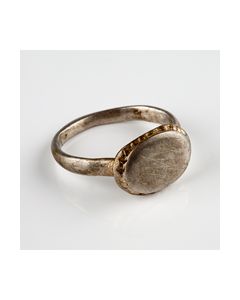 Late-antique silver ring
Late-antique silver ringAngeschmiedete ovale Ringplatte mit umlaufender Verzierung. Der Silberring ist theoretisch auch heute noch tragbar. Innendurchmesser 18mm bis 19mm.
Price: on request Polygonales spätantikes Gewicht
Polygonales spätantikes GewichtDomförmiges Metallgewicht, durch Abflachungen polygonal. 6. bis 8. Jh. n. Chr., antike Einheit 1 Drachma.
Price: on request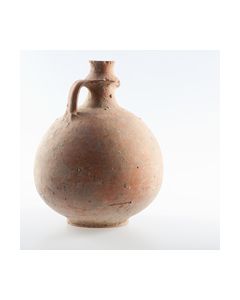 Kugelbauchiger Doppelhenkelkrug
Kugelbauchiger Doppelhenkelkrugmit scheibenförmigem Halsring über dem Henkelansatz. Geschweiftes Mundstück. Rotbrauner Ton. Mit Standring.
Price: on request Gewicht aus früher islamischer Zeit
Gewicht aus früher islamischer ZeitAntikes Gewicht aus der Zeit der arabischen Expansion und der anschließenden, islamisch geprägten Zeit. 16,2g, entsprechend ca. 1/2 Uqiyyah (Waqiyyah).
Price: on request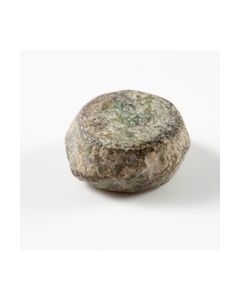 Islamisches Gewicht aus Bronze
Islamisches Gewicht aus BronzeAntikes Scheibengewicht. Typisch für die ausgehende byzantinische und frühe islamische Zeit. 6. bis 8. Jh. n. Chr. Entsprechend ca. 1/2 Mithqal. Schöne Patina.
Price: on request Roman brooch of a swimming bird
Roman brooch of a swimming birdStylized bird shaped brooch made of bronze. Northern European brooch type from the Roman Pricipate.
Price: on request Kanaanitische Öllampe
Kanaanitische ÖllampeEinschnauzige Schalenlampe, flache Form, mit Rußspuren. Rötlicher Ton. Eisenzeit I, 1200 v. Chr. - 900 v. Chr.
Price: on request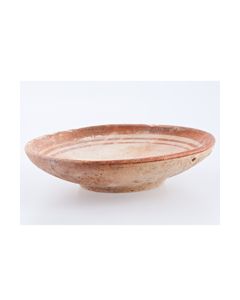 Canosiner Teller
Canosiner TellerFlacher Teller mit Ringstandfuss. Am Rand Dekor durch 3 Kreise aus roter Farbe, zwei weitere Kreise in der Gefäßmitte.
Price: on request Egyptian scarab with papyrus plants
Egyptian scarab with papyrus plantsScarab amulet made of bright, almost white steatite. 13th to 15th dynasty. This scarab is described in the catalogue of Irène Gautier-Vodoz.
Price: on request Scarab with scarab motive
Scarab with scarab motiveThe stamp side shows a scarab with two uraeus snakes. This scarab is described in the catalogue of Irène Gautier-Vodoz.
Price: on request Small scarab amulet with Isis hieroglyphs
Small scarab amulet with Isis hieroglyphsThe tiny amulet dates to the New Kingdom. It bears the glyphs for the goddess Isis. This scarab is described in the catalogue of Irène Gautier-Vodoz.
Price: on request Scaraboid with twisted cord
Scaraboid with twisted cordScaraboid seal amulet with a twisted cord motive. This scarab is described in the catalogue of Irène Gautier-Vodoz.
Price: on request Scaraboid with Red Crowns of Lower Egypt
Scaraboid with Red Crowns of Lower EgyptThe hieroglyphs on the lower side symbolize the rule over Lower Egypt. The rising sun is symbolized above. This scaraboid is described in the catalogue of Irène Gautier-Vodoz.
Price: on request Ramesside Scarab
Ramesside ScarabEgyptian scarab from the 19th to 20th dynasty. With horse and hieroglyphs.
Price: on request Scarab with inscription Amun Re
Scarab with inscription Amun ReInteresting scarab from the New Kingdom. With hieroglyphs reading Amun Re, main god of Theben, and lotus flower.
Price: on request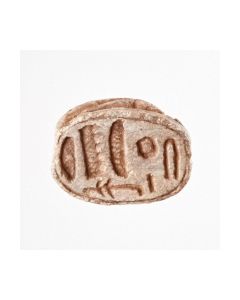 Scarab with inscription
Scarab with inscriptionThe lower side bears a hieroglyph inscription. Nice piece from the Freemark collection. New Kingdom.
Price: on request Scarab with cross symbol
Scarab with cross symbolA piece from the Ramesside Period to the early Third Intermediate Period of ancient Egypt. Great early 20th century provenance.
Price: on request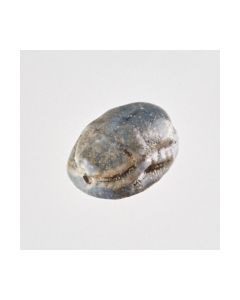 Scarab with blue fayence glaze
Scarab with blue fayence glazeThe piece is from the Third Intermediate Period or the Late Period of ancient Egypt. The inscription refers to Amun-Re, the main god of Theben. The glaze is shining in vivid blue colour.
Price: on request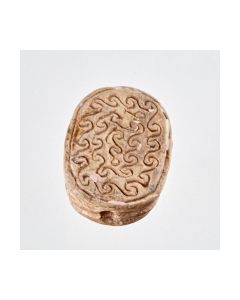 Scarab with spiral design and symbol for good luck
Scarab with spiral design and symbol for good luckThe Egyptian scarab from the Second Intermediate Period is decorated with a geometrical pattern. A nefer hieroglyph stands for good luck.
Price: on request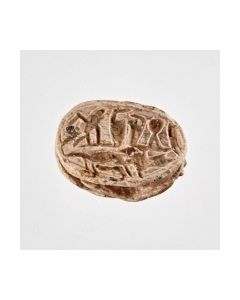 Scarab from the Ramesside period
Scarab from the Ramesside periodThe bottom side shows Horus, Uraeus and crocodile. The crocodile could be interpreted a the god Sobek.
Price: on request Zoomorphic vessel in the shape of a zebu
Zoomorphic vessel in the shape of a zebuThe Western Asiatic vessel amazes by its size and state of preservation. Including TL analysis. Around 1000 BC.
Price: on request Egyptian Scarab with sun beetle
Egyptian Scarab with sun beetleThe scarab amulet from Ramesside times has a beetle engraved in the lower side, flanked by two symbols.
Price: on request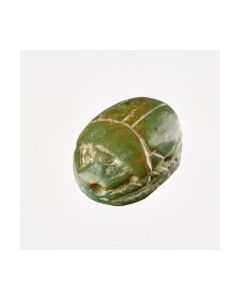 Scarab with Amun inscription
Scarab with Amun inscriptionBearing the hieroglyphs "the god Amun of Theben is lord". From the Late Period of ancient Egypt. Beautiful green stone.
Price: on request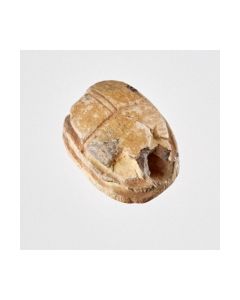 Egyptian Scarab with hieroglyphs
Egyptian Scarab with hieroglyphsInteresting scarab made of steatit with inscription for Amun. Dating to the 19th to 21st dynasty of ancient Egypt.
Price: on request Scarab with geometric motive
Scarab with geometric motiveThe lower side exhibits a symmetrical arrangements of cords, two of which are wrapped around each other. This scarab is described in the catalogue of Irène Gautier-Vodoz.
Price: on request Bracelet with snake heads
Bracelet with snake headsMassive bronze bracelet dating to Late Antiquity. Snake shaped terminals.
Price: on request Gruppe kubischer Gewichte aus Judaea
Gruppe kubischer Gewichte aus Judaea6 antike Gewichte aus Judaea. Gruppe kubischer Gewichte aus massivem Blei
Price: on request Glasierte persische Öllampe
Glasierte persische ÖllampeLanggezogene Schnauze, runder Körper, Henkel als Lilienblatt geformt mit Dekor. Restauriert.
Price: on request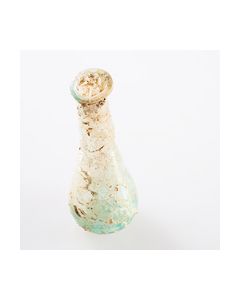 Kleines römisches Glasfläschchen
Kleines römisches GlasfläschchenHell-türkis schimmerndes Glas. Kleines Gefäß aus dem 1. bis 2. Jh. n. Chr., 71mm hoch.
Price: on request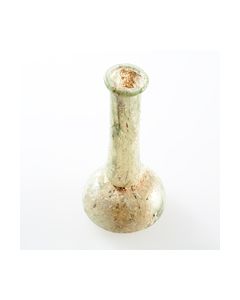 Antikes Glasfläschen
Antikes GlasfläschenAntikes Unguentarium aus der oströmischen Provinz, 1. bis 3. Jh. n. Chr., Höhe 85mm.
Price: on request Antikes Gewicht aus Judaea
Antikes Gewicht aus JudaeaRechteckiges Gewicht aus Blei, Fund aus Israel. 47,4 Gramm. Entsprechend 7 Sicilici.
Price: on request Antikes Gewicht aus Judaea
Antikes Gewicht aus JudaeaQuadratisches Gewicht aus Blei, Fund aus Israel. 33,6 Gramm. Entsprechend 5 Sicilici oder 4 Schekel.
Price: on request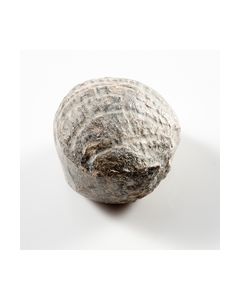 Verziertes Gewicht aus früher islamischer Zeit
Verziertes Gewicht aus früher islamischer ZeitAntikes Gewicht aus der Zeit der arabischen Expansion und der anschließenden, islamisch geprägten Zeit. 20,3g, entsprechend ca. 6 1/2 Dirhem/Dirham.
Price: on request Islamisches Gewicht aus Bronze
Islamisches Gewicht aus BronzeAntikes Scheibengewicht. Typisch für die ausgehende byzantinische und frühe islamische Zeit. 6. bis 8. Jh. n. Chr. Entsprechend ca. 1/2 Mithqal oder 1/2 Numisma.
Price: on request

